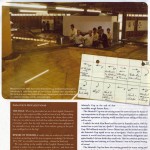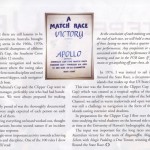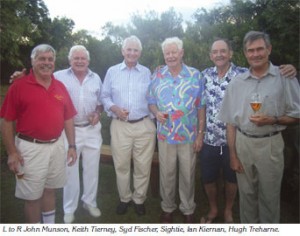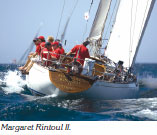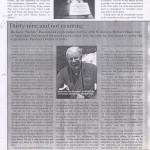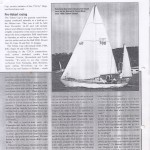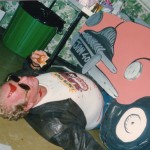| Richard Hammond | |
|---|---|
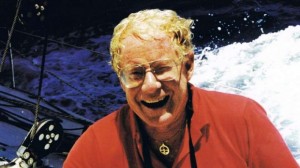 Loved to laugh: Richard ''Sighty'' Hammond 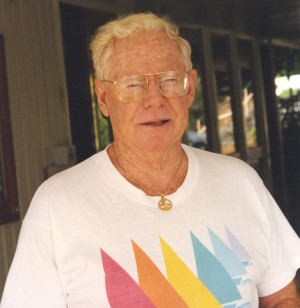 | |
| Other Name | Sightie Hammond, Dick Hammond, Sighty Hammond |
| Gender | Male |
| Date Born | 1933 |
| Status | Deceased |
| Date of Death | 2013 |
| Nationality | Australian |
| Hometown | Sydney |
| Club | Cruising Yacht Club of Australia Middle Harbour Yacht Club |
| Boats Sailed On | Apollo III Apollo IV B195 Canon Maris Condor Crusade Ginko Inch By Winch Janzoon Janzoon II Margaret Rintoul II Maxi Ragamuffin Mercedes V Prospect of Whitby Ragamuffin IV Ragamuffin VI Sovereign Uomie Vengeance Wanderer |
| Web Pages | static.cyca.com.au/media/2958297/Dick-Norman-Colin-Betts-Richard-Hammond-Jazoon-Boys.pdf |
Richard Hammond
From MHYC: The First 60 Years
Article by: Vanessa Dudley
Published: 1999
In 1998, Richard 'Sightie' Hammond sailed in the Sydney to Hobart. 'People ask me Why I keep doing the Hobart race. The fact is, I like it and I'll keep doing it if my health is maintained. I don't get sick - I've never been sick. I just love the camaraderie and the excitement and the thrill and the whole thing.'
Hammond has sailed in 40 Sydney to Hobart races, most of them as navigator, and he holds the record for the most races sailed. 'The number of races has never been really important to me; it just happened.'
Hammond's first Hobart race was in 1952 on Wanderer. He started as a for'ard hand and steerer and he retains vivid memories of that year 'because it was my first one. I never went to bed - I was too excited and involved in everything going on.'
He sailed again on Wanderer in the 1953 and 1954 Hobarts. Then came his years with Russell Slade's Janzoon. Slade had been an idol to the young Hammond as a skipper in the Manly 16-foot Skiff Club ranks. 'I couldn't get on his skiff, but I could sail on his yacht', Hammond recalled.
It was around this time that Hammond became interested in navigation. He explained: 'I discovered fairly early that the biggest single gain to be made was by being able to know exactly where you were and where youwanted to be. It was nothing to do with how good your sails were or things like that.' Slade asked Hammond if he was interested in taking on the role of celestial navigation, and 'that's how it all started'.
'I was really interested in it and really keen to master it. It helped that I'd done quite a lot of surveying, so I was used to the instruments; I had been a very good rifle shot, and this may sound vain, but I was pretty good at taking celestial sights.
'I bought the lightest-framed sextant I could find. I also developed some of my own techniques; a bit unconventional, not always three star fixes. And I always did a lot of pre-planning of races.
'With the Hobart and all the east coast sailing we do, it's important to know your longitude. You must know if you're closing the coast.
'We were fortunate then that we have Sirius, the brightest star in the sky, sitting out there in the east at the time the Hobart race is on. If you can get the object you're taking a fix on at right angles like that, it's easier to work out your longitude. I prided myself on being able to get a good sight.'
Hammond's growing reputation as an offshore sailor and tactical navigator burgeoned into representative sailing for Australia at major international regattas such as the Admiral's Cup and Clipper/Kenwood. He was team navigator with the winning Mercedes V for the 1967 Admiral's Cup, and again on Syd Fisher's Ragamufiin in 1979, winning the cup in atrocious conditions in a race where 15 yachtsmen died.
He has been on two Hobart handicap winners: Koomooloo in 1968, and the maxi Sovereign, which also took line honours for the rare double victory in 1987. There was a second line honours win on Crusade in 1969. He considers the toughest race of his experience to be the 1979 Fastnet Race.
When asked which yacht he would rate as the best he had raced to Hobart, Hammond paused for a while before his face lit up with pleasure: 'Gingko' was an absolute dream to sail on and we had the best crew. It was an exciting boat to sail, it won nearly every race it entered. We had Carl Ryves, Sarge (Dick Sargeant); Benny (Ben Lexcen), Poddy (Pod O'Donnell).
'We had a boat-on-boat race with Ragamuffin and Apollo 2 from the start (of the 1972 Hobart) to the finish and we were pretty unlucky not to win. American Eagle was just at Tasman Light when the wind went from north to south; they got around and home.'
After sailing on progressively bigger and bigger boats to Hobart, Hammond said that when Ian Kiernan asked if he'd join the crew of the Canon Maris for the fiftieth race: 'I was happy to go back on a boat the same size as I used to go on. It felt exactly the same as when I went before - Wet and crashing around. I liked it.' Canon Maris is an 11.3-metre Tasman Seabird designed by Alan Payne and launched in 1958.
Comparing the older boats to the modern racers, 'Boats like Canon Maris bury in the water downwind, right down to the deck level; the modern boat is a lot more thrilling to sail downwind.
'I don't like what they've done with the ballast of the modern boats, taking it out of the keel so you have to stick the crew on the rail and they're not allowed to get off. I don't want to sail like that and I think they've lost the plot a bit there, compared to the days of the nice solid boat capable of withstanding hard weather and with proper eating and sleeping conditions.
'I'm not criticising the new boats - you've got to go ahead -- but I do worry a bit how strong they are and their ability to withstand some of the weather I've been through.'
His reputation as a tactical navigator, approaching every race as thoroughly prepared and with as many things pre-planned as possible, continues today. Things are different now, of course. 'Now you've got the boat GPS and a hand-held GPS as standby and that's all you need',
Hammond says.
Hobarts | 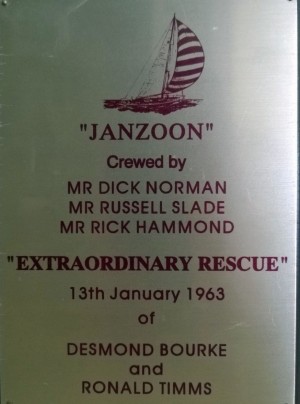 Janzoon Extra Ordinary Rescue From the CYCA Website, data provided by David Kellett.
Richard sailed in 40 Hobarts and was winner twice
|
Sightie's Story |
Sightie's 75th | Sightie's seventy fifth by Patrick Bollen Afloat Magazine May 2008 http://www.afloat.com.au/afloat-magazine/2008/may-2008/Sighties_seventy-fifth#.Vrp81vl96Uk Patrick 'Tenpin' Bollen catches up with distinguished ocean racing navigator Richard 'Sightie' Hammond. Considered by many of his peers as perhaps one of the best ocean racing navigators of his time along with the late Stan Darling, Bill Fesq and Englishman Peter Bowker, Richard 'Sightie' Hammond recently celebrated his 75th birthday at his home in Clontarf. Guests included such noted Australian ocean racing identities and Hobart winners as Syd Fischer and Trygve Halvorsen, Don Mickelborough, Ian Kiernan AO, Hugh Treharne, Frank Tolhurst, Dick Sargeant, Jack Baxter, Ken Beashel, Sir James Hardy, and his boyhood pal and long-standing friend Colin Betts. Born in 1933 at Coffs Harbour, Richard was educated at Manly West Primary where he was Dux of the School winning a scholarship to North Sydney Boys High. After some deliberation based on curriculum he opted instead to complete his schooling at North Sydney Technical College. He then went on to night school to complete an Engineering degree at the University of Technology in Ultimo. His first job at the age of 21 was with the Sydney Water Board. Shortly after he joined Civil & Civic which later became what is today Lend Lease. Civil & Civic won the contract to build the Sydney Opera House Stage One and Richard was appointed the project's Site Engineer. He also worked as Project Manager on the innovative Australia Square Tower constructed by Dutch engineer/developer and C&C boss Dick Dusseldorp, a man Hammond best describes as a 'genius'. Sir Frank Packer asked the Civil & Civic Group to retrofit the then Daily Telegraph premises in Castlereagh Street, firstly knocking down the old Lombard Chambers which housed the printing presses and add six new stories to the then Head office of Consolidated Press also in Castlereagh Street. At the same time property was purchased in Park Street to erect a new building to house Consolidated Press's head office. The building is still the headquarters of the Packer empire, PBL. Hammond recalls a conversation with Sir Frank about the purchase of the Park Street property. "Sir Frank and I were standing on the roof of the property and he asked me how much the property will cost. I tell him it will cost �93,000. '�93,000!' shrieks Sir Frank and I reply 'yes, but Sir Frank that's only chicken feed.' Packer's retort stops me in my tracks; 'Look sonny, �93,000 is never chicken feed, don't you ever forget that for the rest of your life - I'll buy it.'" In 1970 Hammond was appointed to the position of Commercial Design Director, Lend Lease. Hammond's sailing career started at the age of seven when his mother Olga bought him a seven foot canvas canoe. "I rigged this thing to make it sail. Mum made the sails from sheets and I got whatever wood I could to make a mast. Back then the war was on and you couldn't get metal so I made fins from fibro. It was a shocker to windward so I'd paddle up to Manly Wharf set the sails and sail down past Fairlight then into the shallow waters of North Harbour, pull the sails down and paddle back to Manly once more. I'd do this all afternoon till it got dark." Aged thirteen Sightie graduated to his first dinghy. "Dad was a Captain on one of the US warships and after the war while his ship was in Sydney he ordered two nine-foot clinker dinghies be put ashore at Lavender Bay and painted grey. When he came home on leave he presented me with my first real boat. I took two mates with me and we rowed the boat back to Fairlight Beach capsizing it as we tried to crack a wave to the beach. "I was sailing competitively on a 12-foot skiff with Tup Blackwell, a shipwright from Treharne's Boatshed in North Harbour. I was pretty good with tools but Tup showed me a few things and I made a bowsprit, a mast, built a keel and a tiller then stripped the dreadful looking war grey paint from the hull rejuvenating the clinker boat to a gloss green finish and sailed her in the North Harbour regattas. "While sailing these boats I was also sailing other people's boats. One in particular was a boat called U-Vee which was a smaller version of Jack Lyons' boat U-Dear in which he won the Australian Championships. I also bought Max Barnett's Scamp. Max would let me use the boat when he went to the races. "I then went into 16ft skiffs and sailed with Peter Browne on Solo 1 and Solo 2 in which we won two club championships." This was a good time for Sightie as a bloke named Russell Slade was the club champion for such a long time and no one could knock him off. "I approached Russell and asked him if I could sail with him and he asked me why and I said because I want to sail with winners. "I missed out because Russell took Col Betts on as sheet hand. I started sailing with Russell when he got into yacht racing with Janzoon I. However, my first ocean racing was on a yacht called Wanderer in 1952. We did the '52, '53 and '54 Hobart races." In 1953 Sightie at age 20 was the junior hand on Janzoon in the Montague Island race when the fleet was hit by a big southerly after rounding the island. "We did a full-standing gybe and lost the rig and our helmsman Tom Faulkner, the former boss of Tooth and Co, over the side. Doug Brown dived into the raging sea and swam 100 yards to save Tom and bring him back to the boat. After we sorted out the mess we retired to Ulladulla." From 1955 to 1966 Hammond sailed with Russell Slade on Janzoon I and then the famous Alan Payne designed, Janzoon II, which was the first fibreglass boat built in Australia. In 1967 Sightie had his first taste of international victory when sailing aboard the Ted Kaufman design Mercedes III and, along with Gordon Ingate's Caprice of Huon and Sir Robert Crichton-Brown's Balandra, won ocean racing's then Holy Grail the Admiral's Cup. Then in 1968 he joined a young Dennis O'Neill aboard the beautiful Koomooloo with his mates Dick Norman and Col Betts winning the Sydney to Hobart classic that year. Hammond's ocean racing career just got better and in 1971 he joined Englishman Arthur Slater aboard Prospect of Whitby and in 1972 navigated the remarkable Lexcen design Gingko for Gary Bogard. That year Gingko finished third in the Hobart race behind American Eagle (Ted Turner) and Caprice of Huon. Following this, Sightie joined Alan Bond's Apollo III competing in the 1974 and '75 Hobart races. At the same time Jack Rooklyn contacted Richard asking him to project manage the building of the exciting new maxi Ballyhoo which went on to defeat the then world-beating famous American glamour maxi Kialoa III in the 1976 San Francisco Big Boat Series before returning to Australia to claim line honours in the Hobart race that same year. Then, the late Stan Darling was navigator on Ballyhoo. By this time Sightie had already completed 20 Hobart races. In 1976 he raced with Matika III and in ensuing years he navigated such famous Aussie ocean racers as B195, Apollo IV, Ragamuffin, Inch by Winch, Apollo V, Bondi Tram and the 1981 Hobart line honours winner Vengeance (formerly Siska) for property developer Bernard Lewis. In 1979 Sightie joined Syd Fischer as navigator/tactician on the highly successful fourth Ragamuffin which along with team members Impetuous (Graeme Lambert) and Police Car (Peter Cantwell) won the Admiral's Cup in which 15 sailors lost their lives in the devastating Fastnet race. Sightie had now notched up his second Admiral's Cup victory. He was a member of seven Australian Admiral's Cup teams from 1967 to 1983. In 1986 Bernard Lewis launched his new and mighty Dave Pedrick design Sovereign. Hammond joined as navigator/tactician on Sovereign that year and again in 1987 when he was instrumental in delivering Lewis the Hobart double of both line and handicap honours. This gave Sightie his second Hobart double. From 1990 to 1999 Sightie navigated Condor (Tony Paola), Final Approach for the late and great American Don Johnson, Maxi Ragamuffin, Margaret Rintoul II (Richard Purcell) and his last three Hobarts with his good mate Ian Kiernan aboard the beautiful 36-foot Tasman Seabird Maris. His final Hobart race in 1999 chalked up a remarkable 40 Sydney to Hobart Races. While 'Sightie' stopped racing in 2000 as a result of deteriorating vision, he's off to off to cruise Croatia in June with 'Tig' Thomas and the Middle Harbour Cruising Club. |
Thirty Nine and Not Counting |
Obituary | RICHARD HAMMOND 1933-2013 Sydney Morning Herald December 27, 2013 A distinguished navigator and strategist who ranks among Australia's greatest yachtsman, Richard ''Sighty'' Hammond also played a significant part in the shaping of the modern Sydney skyline. He was engineer and project manager during the construction of the Sydney Opera House, Australia Square and the MLC Centre, and also oversaw the development and construction of another Sydney landmark, St Vincent's Private Hospital. As yachtsman and businessman, he never gave up on anything he set out to achieve, nor met a problem he did not believe he could solve, and was held in the highest regard as a mentor and teacher of Australian navigators. Hammond's impressive record of ocean-racing achievements included 40 Sydney to Hobart races, victories in the Clipper Cup series in Hawaii, the Cowes to Dinard race, Lord Howe Island race, Maxi Yacht World Championship and many more. He sailed with a who's who of international yachtsmen, on the most famous vessels. Seven times he was on the Australian Admiral's Cup team, for two victories, and was instrumental in Australia's first win in 1967, navigating Mercedes III for Ted Kaufman. This biennial event was held in the English Channel, with national teams of three boats , and was the holy grail of international yachting at the time. For the 1967 race, Hammond, with typical ingenuity, researched the swirling tides of the Solent at the University of Southampton, plotting various readings through the tide cycle and filing them on cards to be used as conditions warranted: his work set Australia up for a famous victory. Advertisement
In later years, Admiral's Cup team preparation always involved Hammond - and many young Australian sailors have been taught to use tidal flow by those who are passing on knowledge that originated from ''Sighty''. Richard Leo Hammond was born in Coffs Harbour on January 14, 1933, and moved to Fairlight in Manly with his parents, Harry and his wife, Olga (nee du Chateau), aged one year. Richard never moved far from Manly and the harbour; his third home was at Clontarf or, as he preferred, latitude 33o 49' south, longitude 151o 15' east. Hammond used to say he gave Olga quite a hard time. He was bright, bossy and loved practical jokes. Harry was frequently away during and after World War II, captaining US navy vessels. Richard became the man of the house and took on a fatherly role with his brother Warwick, eight years younger. At seven, Richard's sailing career began when Olga gave him a canvas canoe, which he rigged with home-sewn sheets, a mast made from scavenged wood and fibro fins, as metal was in short supply due to the war. It was ''a shocker to windward'' so the boy spent afternoons alternately sailing from Manly Wharf to North Harbour, and then paddling back. By 13 he was already sailing competitively, and then his father gave him a nine-foot ex-US navy clinker dinghy, which he and two mates rowed to Fairlight from Lavender Bay. Again he rigged it up to sail, and took part in the North Harbour regattas. He soon moved up to racing 16-foot skiffs and his first ocean racing was on a yacht called Wanderer in 1952. Richard was dux of Manly West Primary School, and went on to North Sydney Technical High, where he was more interested in sailing than studying. But he was voted prefect and then studied civil engineering at Broadway Technical College. His first job as an engineer was at the Metropolitan Water Sewerage and Drainage Board. But these were times of opportunity for a talented young man and, in 1958, he joined Civil and Civic to work on the Opera House's cement podium as site engineer. He then became involved in the design process for Australia Square with architect Harry Seidler. At the time, it was the tallest reinforced concrete building in the world and Hammond, though young, led the design team. He already displayed his ability to analyse issues, formulate a strategy and achieve a successful outcome. He was a perfectionist and innovator and he brought these skills to many other projects, helping turn the role of project manager into a profession integral to the design and construction of major buildings in cities across Australia. He went on to become design director of Lend Lease, under friend and mentor Dick Dusseldorp. In 1958, Hammond married ''the beautiful girl'' Margaret Kimmorley, whom he had known for two years. Margaret focused on raising their three children, while Richard immersed himself in work and sailing, and never lost his joie de vivre. He loved to laugh, and while the family home overflowed with friends and visitors from around the world, he also made time for his children, practical jokes and having sheer joyful fun. Hammond navigated with Ben Lexcen (Ginkgo, Apollo III), Syd Fischer (Ragamuffin), Arthur Slater (Prospect of Whitby, UK), David Kellett (Sovereign, Vengeance and Condor), John Bertrand (Superstar and Apollo V) and many other renowned yachties. But possibly the victory that gave him the most pleasure was the 1968 Hobart race, on Koomooloo for Denis O'Neil; not only was it his first Hobart win but also on the crew were Dick Norman and Colin Betts, his great friends since the early 1950s. In 1970, Hammond began his own consulting business, Richard Hammond & Associates. He was invited to submit a project management proposal for the rebuilding program at St Vincent's Private Hospital, which brought him into contact with another important person in his life, the legendary Sister Bernice Elphick. The medical centre project had languished in the too-hard basket for a decade and the private hospital was poorly conceived. Hammond's proposal was approved, and with his typical efficiency the medical centre was built and completed in 1972. He went ahead with a detailed feasibility study for a new private hospital: construction began in 1972 and in spite of many obstacles, including skyrocketing labour costs, the modern facility exceeded expectations. It was opened in 1977 and was fondly dubbed ''the Darlinghurst Hilton''. Hammond joined the advisory board and remained there working with Sister Bernice for 10 years, during which the multi-disciplinary St Vincent's Clinic was conceived and completed in 1990: another Sydney landmark testament to his broad range of skills. Hammond was also generous: due to his association with St Vincent's, he knew the best doctors and helped hundreds of people get the very best medical treatment. Margaret died in 1990. Later, Hammond reconnected with Doreen Holland, whom he had met many years before. He sailed his last Hobart race in 1999, with his good mate Ian Kiernan aboard the 36-foot Canon Maris. This yacht was not fitted out with the latest navigational equipment because of its age, so Hammond was able to do what he did best, navigate by the stars. Richard Hammond is survived by Doreen and her family, children Julianne, Murray and Joanne and their families and brother Warwick. Read more: http://www.smh.com.au/comment/obituaries/richard-hammond-distinguished-navigator-and-strategist-20131226-2zxgq.html#ixzz3zimPOaHS Follow us: @smh on Twitter | sydneymorningherald on Facebook |





